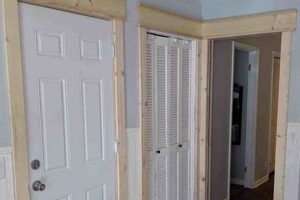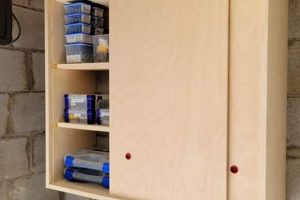The construction of sliding doors, inspired by traditional agricultural architecture, undertaken by individuals themselves. This process involves procuring raw materials, cutting them to size, assembling the door panel, and installing the necessary hardware for smooth lateral movement. Examples include crafting a door from reclaimed wood, fitting it with a track and rollers purchased separately, and mounting it within a residential doorway.
This method of door construction offers several advantages. It allows for customization in terms of size, style, and materials, enabling homeowners to create a door that perfectly complements their existing dcor. Furthermore, it can be a more cost-effective alternative to purchasing pre-made doors, particularly when utilizing repurposed lumber or sourcing hardware independently. Historically, similar space-saving designs were implemented in agricultural settings to maximize usable area within barns and related structures.
The following sections will explore essential considerations for successful door construction, including material selection, hardware choices, installation techniques, and relevant safety precautions. These details will provide the reader with a foundational understanding for undertaking such a project.
Essential Tips for Barn Door Construction
This section offers crucial recommendations for achieving a successful and aesthetically pleasing sliding door installation. Careful planning and precise execution are essential for optimal functionality and longevity.
Tip 1: Accurate Measurement is Paramount: Prior to material acquisition, meticulously measure the door opening. Account for any necessary overlap to ensure adequate privacy and light blocking. Incorrect measurements can lead to costly material waste and functional issues.
Tip 2: Select Appropriate Hardware: The track and roller system must be rated to support the weight of the completed door. Consider the material and construction of the door when determining load capacity. Insufficient hardware can result in premature failure and potential safety hazards.
Tip 3: Prioritize Structural Integrity: When assembling the door panel, ensure that all joints are securely fastened. Utilize wood glue and screws or nails to create a robust frame. A structurally sound door will resist warping and sagging over time.
Tip 4: Employ Proper Finishing Techniques: Apply a protective finish to the door surface to guard against moisture and wear. Consider the intended aesthetic and choose a finish that complements the surrounding dcor. Proper finishing enhances durability and visual appeal.
Tip 5: Ensure Smooth Track Installation: The track must be perfectly level for smooth and effortless door operation. Use a level and appropriate shims to correct any imperfections in the wall surface. An uneven track can cause the door to bind or derail.
Tip 6: Consider Safety Features: Implement safety features such as soft-close mechanisms to prevent slamming and finger pinching. These additions enhance safety and user experience, especially in households with children.
Tip 7: Pre-Drill Pilot Holes: When attaching hardware, pre-drill pilot holes to prevent wood splitting. This technique is particularly important when working with hardwoods. Pilot holes ensure secure and accurate fastener placement.
Adhering to these guidelines will contribute significantly to the successful completion of the door project, resulting in a functional and visually appealing addition to any space.
The following section will address common challenges encountered during the door construction process and offer practical solutions.
1. Material Selection
Material selection exerts a profound influence on the outcome of a door construction project. The chosen materials determine the door’s aesthetic qualities, structural integrity, weight, and overall longevity. Therefore, careful consideration of material options is paramount for a successful implementation.
- Wood Type and Grain
The species of wood employed directly impacts the door’s appearance and performance. Hardwoods like oak and maple offer superior durability and resistance to wear, while softwoods like pine and cedar are more cost-effective and easier to work with. The grain pattern of the wood also contributes to the door’s visual appeal and can influence the finishing process. For example, a rustic design may benefit from the pronounced grain of reclaimed wood, whereas a more contemporary style may call for a smoother, more uniform surface.
- Reclaimed vs. New Lumber
The choice between reclaimed and new lumber introduces different considerations. Reclaimed wood imparts a unique character, often bearing marks of previous use that add to its aesthetic. However, it may require more extensive preparation, including cleaning, sanding, and stabilization, to ensure its suitability. New lumber offers greater uniformity and predictable properties but lacks the distinctive charm of reclaimed materials.
- Panel Material
The panel material, if applicable, contributes significantly to the door’s weight, insulation properties, and visual design. Options include solid wood, plywood, MDF (Medium-Density Fiberboard), and glass. Solid wood panels offer durability and aesthetic appeal but can be heavy. Plywood and MDF are lighter and more cost-effective but may lack the same visual richness. Glass panels introduce natural light and visual interest but require careful consideration of safety and privacy.
- Hardware Compatibility
The chosen materials must be compatible with the intended hardware. For instance, heavy doors require robust track systems and rollers capable of supporting their weight. Similarly, the door’s thickness and composition must accommodate the installation of handles, latches, and other hardware components. Failure to consider hardware compatibility can result in functional issues and safety hazards.
In summary, the careful selection of materials constitutes a cornerstone of successful door construction. Each choice carries implications for the door’s aesthetic, functionality, and durability, underscoring the importance of informed decision-making throughout the design and construction phases.
2. Hardware Compatibility
Successful construction necessitates careful attention to hardware compatibility. The selection of appropriate tracks, rollers, handles, and associated components is critical for ensuring smooth operation, structural integrity, and long-term durability. Mismatched or inadequate hardware can compromise the functionality and safety of the installation.
- Weight Capacity and Track Rating
The track system must be rated to support the combined weight of the door panel and any attached hardware. Exceeding the track’s weight capacity can lead to premature wear, binding, or catastrophic failure. Manufacturers typically provide weight ratings for their track systems, and these ratings should be carefully considered in relation to the door’s total weight. For instance, a solid-core wood door will require a heavier-duty track than a lightweight hollow-core door.
- Roller Design and Track Profile
The design of the rollers must be compatible with the track profile. Rollers with incorrect dimensions or materials may not glide smoothly along the track, resulting in friction, noise, and operational difficulties. Common roller designs include flat-track, round-track, and box-track configurations. It is essential to select rollers that are specifically designed for the chosen track profile to ensure optimal performance. For example, using a flat roller on a round track will lead to instability and uneven weight distribution.
- Door Thickness and Hardware Mounting
The door’s thickness must be sufficient to accommodate the secure mounting of handles, pulls, and other hardware components. Insufficient thickness can prevent proper attachment, leading to loose hardware or structural damage. Consider the thickness of the door panel when selecting mounting screws or bolts. Furthermore, the composition of the door material (e.g., solid wood, MDF) may influence the type of fasteners required for secure attachment. For example, MDF may require specialized screws designed to grip the material without causing splitting.
- Clearance and Space Considerations
Adequate clearance must be maintained between the door, the track, and any surrounding walls or trim. Insufficient clearance can impede the door’s movement and create potential safety hazards. Measure the available space carefully and select hardware that minimizes protrusion from the door surface. Additionally, consider the swing radius of the door when fully opened to ensure it does not obstruct walkways or other fixtures. For example, low-profile track systems can be used to minimize the gap between the door and the wall, maximizing usable space.
These aspects of hardware compatibility are fundamental to the successful construction of a sliding door. By carefully considering weight capacity, roller design, door thickness, and clearance requirements, one can ensure a safe, functional, and aesthetically pleasing final product. Failure to address these factors can result in operational issues, safety concerns, and premature hardware failure.
3. Precise Measurements
Accurate dimensional assessments are critical to the successful execution of any sliding door installation. Deviations from precise measurements can lead to functional impairments, aesthetic compromises, and structural instabilities. This section delineates key considerations for dimensional accuracy in the context of sliding door construction.
- Opening Width and Overlap Considerations
The accurate measurement of the door opening’s width is paramount. Furthermore, consideration must be given to the desired amount of overlap beyond the opening. Insufficient overlap compromises privacy and light blockage, while excessive overlap can impede functionality and create an unbalanced aesthetic. For instance, if an opening measures 36 inches, the door panel may require a width of 40 inches to achieve a two-inch overlap on each side.
- Track Length and Mounting Location
The track length must be precisely calculated to accommodate the full travel of the door and prevent it from overrunning its intended path. Incorrect track length can result in the door either failing to fully cover the opening or colliding with adjacent walls or fixtures. The mounting location of the track, particularly its height, also demands precise measurement to ensure the door hangs correctly and operates smoothly. For example, the track height must account for the roller hardware’s vertical dimension and the desired gap between the door’s bottom edge and the floor.
- Door Panel Dimensions and Squareness
The dimensions of the door panel itself must adhere to strict tolerances to guarantee proper fit and alignment within the track system. Any deviations from squareness or specified dimensions can lead to binding, uneven gaps, and operational difficulties. Ensure that the door panel’s diagonals are equal to confirm squareness before installation. For example, if the door is not square, it may rub against the wall on one side while leaving a large gap on the other when closed.
- Hardware Placement and Alignment
The precise placement and alignment of hardware components, such as rollers, handles, and latches, are essential for smooth operation and structural integrity. Misaligned hardware can cause binding, uneven weight distribution, and premature wear. Measure the distance between mounting holes accurately and ensure that all hardware components are level and plumb. For example, if the rollers are not aligned, the door may wobble or derail from the track.
These elements underscore the critical role of precise measurements in successful sliding door construction. By adhering to strict dimensional accuracy, individuals can mitigate potential issues and achieve a functional, aesthetically pleasing, and durable result. The absence of meticulous measurement can manifest in operational deficiencies and visual imperfections, ultimately compromising the overall quality of the installation.
4. Structural Integrity
Structural integrity constitutes a fundamental requirement for the successful construction and long-term performance of sliding doors. The inherent design of these doors, often incorporating substantial weight and lateral movement, places significant stress on the door panel and its supporting framework. Consequently, inadequate structural integrity can lead to warping, sagging, joint failure, and ultimately, a non-functional or unsafe installation. The selection of appropriate materials, coupled with sound construction techniques, directly influences the door’s ability to withstand these stresses. For example, a door constructed from low-grade lumber with poorly executed joints is far more susceptible to structural failure than a door built from seasoned hardwoods with robust mortise-and-tenon joinery.
The impact of structural deficiencies extends beyond mere aesthetic imperfections. A warped or sagging door may bind against the track, impeding smooth operation and potentially damaging the hardware. Furthermore, a failure of the door panel’s internal structure can create safety hazards, particularly if sections of the door become dislodged. Consider a scenario where a heavy door panel, weakened by inadequate structural support, detaches from its frame during operation. The resulting impact could cause injury or property damage. Therefore, attention to structural integrity is not simply a matter of cosmetic improvement; it is a critical aspect of ensuring user safety and preventing costly repairs.
In summary, the structural integrity of a sliding door is intrinsically linked to its functionality, longevity, and safety. Sound construction practices, including careful material selection, proper jointing techniques, and reinforcement strategies, are essential for mitigating the risks associated with structural failure. While aesthetic considerations are undoubtedly important, they should never overshadow the paramount need for a structurally sound and reliable door system. Prioritizing structural integrity from the outset of the construction process is crucial for achieving a satisfactory and enduring result.
5. Smooth Operation
The achievement of smooth operation represents a critical metric in the successful execution of a sliding door construction project. It reflects the culmination of precise measurements, correct hardware selection, and proper installation techniques. A door exhibiting smooth operation translates to ease of use, reduced wear and tear on components, and a satisfying user experience. Conversely, a door that binds, sticks, or requires excessive force to operate indicates underlying issues that demand rectification. For instance, a door constructed with warped lumber or installed on an unlevel track will inevitably exhibit operational difficulties. This outcome diminishes the practical value of the project, irrespective of its aesthetic appeal.
Several factors contribute directly to smooth operation. The accurate alignment of the track and rollers ensures that the door glides effortlessly along its path. The selection of a track system with an adequate weight rating prevents binding or dragging. The use of high-quality bearings in the rollers minimizes friction and noise. The proper application of lubrication further enhances smooth movement. Consider the scenario of a homeowner who invests time and resources in constructing a sliding door, only to discover that it requires significant effort to open and close. This operational deficiency detracts from the overall functionality and may necessitate costly adjustments or replacements. Therefore, prioritizing smooth operation throughout the construction process is paramount.
In summary, smooth operation is not merely a desirable attribute; it is an essential characteristic of a well-executed sliding door project. It signifies the effective integration of all design and construction elements and contributes directly to the door’s usability and longevity. While aesthetic considerations are undoubtedly important, they should not overshadow the fundamental requirement for a door that operates smoothly and reliably. Addressing potential impediments to smooth operation during the design and installation phases is crucial for maximizing the value and satisfaction derived from this type of home improvement project.
6. Finishing Technique
The application of a finishing technique in the context of door construction directly influences its longevity, aesthetic appeal, and resistance to environmental factors. The selection and execution of an appropriate finishing method are inextricably linked to the overall success of such a project. Without a protective layer, the raw material is susceptible to moisture absorption, UV damage, and physical abrasion, leading to premature degradation. An example would be an unfinished wooden door exposed to direct sunlight, resulting in fading and cracking of the wood. Conversely, a properly finished door can withstand these elements, maintaining its structural integrity and visual appeal for an extended period.
The choice of finishing technique extends beyond mere preservation; it also contributes significantly to the door’s aesthetic character. Staining enhances the natural grain patterns of wood, while painting allows for customization with a wide range of colors and textures. Varnishing or lacquering provides a durable, glossy surface that is easy to clean and maintain. The specific finishing method employed should complement the overall design of the space. For instance, a rustic-themed interior might benefit from a distressed or weathered finish, while a contemporary setting may call for a smooth, high-gloss lacquer. In practical terms, a carefully chosen and properly applied finish not only protects the door but also elevates its aesthetic value, making it a focal point of the room.
In conclusion, the finishing technique represents an indispensable element in the construction of a sliding door. It safeguards the door against environmental damage, enhances its aesthetic appeal, and contributes to its long-term durability. Challenges in selecting an appropriate finish often arise from balancing aesthetic preferences with practical considerations, such as ease of maintenance and resistance to wear. Understanding the connection between finishing technique and overall project success is crucial for achieving a door that is both visually appealing and structurally sound.
7. Safety Considerations
The integration of safety considerations into sliding door construction is not merely a precautionary measure but a fundamental requirement for safeguarding individuals and preventing potential accidents. The inherent weight and mechanics of sliding doors present specific hazards if safety is not prioritized. Improper installation, inadequate hardware, or a lack of preventative features can lead to scenarios involving crushing injuries, falls, and structural failures. For example, a heavy door lacking a soft-close mechanism poses a significant risk of slamming shut, potentially causing harm to fingers or limbs caught in its path. Similarly, a door installed without proper track supports is susceptible to detachment and collapse, creating a risk of impact injuries. Adherence to established safety protocols and the implementation of appropriate safety features are therefore essential components of any sliding door project.
One key area of focus within safety considerations is the selection of appropriate hardware and materials. The track system must be rated to support the weight of the door with a safety margin to account for dynamic loads. The use of tempered glass, if integrated into the door design, mitigates the risk of shattering and severe injuries. The inclusion of safety latches or locking mechanisms can prevent accidental sliding in high-traffic areas or during inclement weather. Moreover, the implementation of accessibility considerations, such as lever handles and adequate clearance around the doorway, is essential for ensuring the safety of individuals with mobility limitations. These measures demonstrate how proactive safety planning can minimize potential risks and promote a secure environment.
In summary, the deliberate integration of safety considerations is not optional but integral to responsible sliding door construction. While aesthetic appeal and functionality are important aspects, they should never supersede the need for a safe and reliable door system. Challenges in addressing safety considerations often arise from cost constraints, a lack of technical expertise, or a failure to anticipate potential hazards. However, by prioritizing safety from the outset of the project and adhering to industry best practices, individuals can significantly reduce the risk of accidents and ensure the well-being of those who interact with the door.
Frequently Asked Questions about Barn Door Construction
This section addresses common inquiries regarding the creation of sliding doors inspired by barn designs. The information provided aims to clarify misconceptions and offer practical guidance for successful project completion.
Question 1: Are specialized tools necessary for door construction?
While basic woodworking tools such as a saw, drill, and measuring tape are essential, specialized equipment can enhance precision and efficiency. A table saw facilitates accurate cutting of large panels, and a router can create decorative edge profiles. The necessity of specialized tools is contingent upon the complexity of the intended design and the desired level of craftsmanship.
Question 2: What constitutes an appropriate track system for a heavy door?
An appropriate track system must possess a weight rating that exceeds the door’s total mass, including hardware. Seek systems constructed from robust materials like steel or reinforced aluminum. The roller design should also be compatible with the track profile, ensuring smooth and stable operation. Consult manufacturer specifications to confirm compatibility and weight capacity.
Question 3: How can warping be prevented during door construction?
Warping is mitigated by utilizing seasoned lumber with a low moisture content. Employ construction techniques that promote structural rigidity, such as interlocking joints and diagonal bracing. Proper storage of materials before and during construction is crucial to prevent moisture absorption. Applying a sealant or finish can also help to stabilize the wood and reduce the risk of warping.
Question 4: What safety precautions are essential during installation?
Wear appropriate safety gear, including eye protection and gloves. Ensure that the mounting surface is structurally sound and capable of supporting the weight of the door. Use proper lifting techniques to avoid back strain. Disconnect electrical power if working near wiring. Enlist assistance for heavy lifting and complex installation steps.
Question 5: How does one achieve a professional-looking finish on a self-made door?
Thorough surface preparation is paramount. Sand the door surface to a smooth, even texture. Apply a primer to promote adhesion and uniform color. Use high-quality paints or stains specifically designed for wood. Apply multiple thin coats, allowing each coat to dry completely before applying the next. Consider using a clear topcoat for added protection and durability.
Question 6: What are the code considerations for interior sliding doors?
While interior sliding doors typically do not require adherence to strict fire-rating codes, they must comply with general building safety regulations. Ensure that the door does not obstruct egress pathways or create tripping hazards. Consult local building codes to confirm specific requirements related to door size, swing direction, and accessibility.
The answers provided offer insights into frequently encountered challenges and considerations associated with sliding door projects. Successful implementation hinges on careful planning, precise execution, and a commitment to safety.
The next section will explore advanced techniques and customization options for sliding door projects.
Concluding Remarks on Barn Doors DIY
This exploration has detailed various facets of constructing sliding doors, drawing inspiration from agricultural precedents. Key points covered include material selection, hardware compatibility, dimensional accuracy, structural integrity, operational smoothness, finishing techniques, and critical safety considerations. Each element contributes significantly to the overall success and longevity of such a project, demanding meticulous attention to detail and a commitment to sound construction practices.
The construction of sliding doors is not merely a superficial home improvement endeavor. It represents a commitment to craftsmanship, resourcefulness, and the integration of functional art within a living space. A successful project requires diligent planning, unwavering execution, and a thorough understanding of the principles outlined. The pursuit of quality and safety should guide every decision, ensuring a lasting and valuable addition to any environment.







